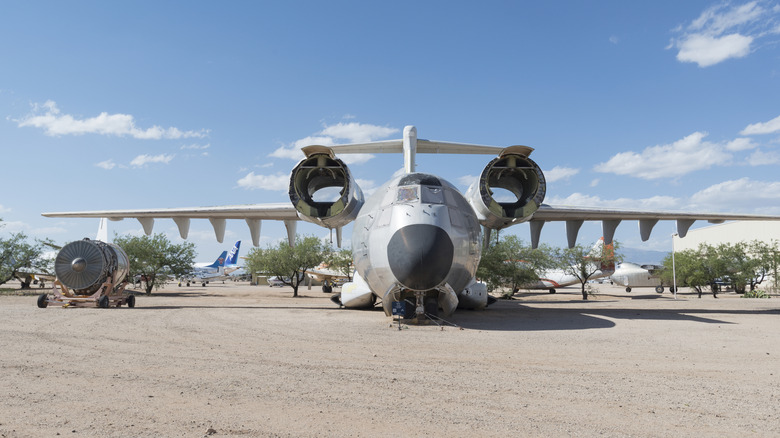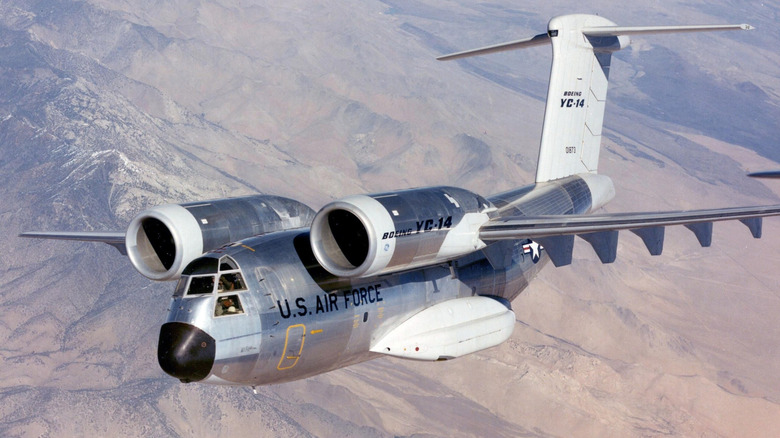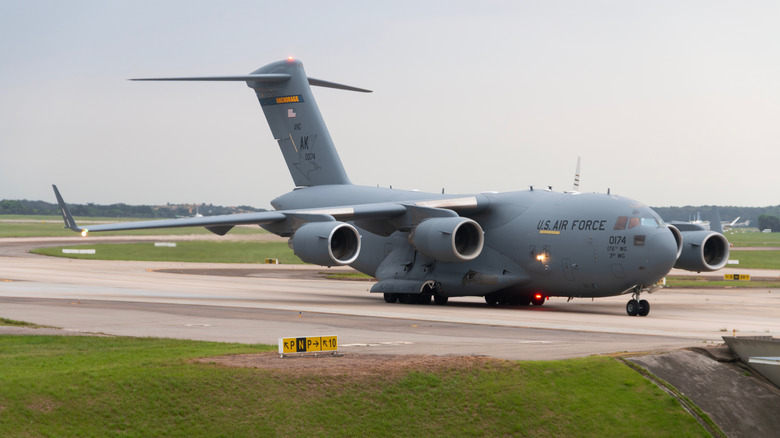This Clever Design Made Boeing's YC-14 The King Of Short Runways
For a cargo plane, you might think that the general rule would be a simple one: The bigger, the better. The aircraft's primary role, of course, is to deliver supplies, equipment, troops, or whatever else is needed of them. The larger and more spacious they are, the more versatile they can be, and potentially, the less cargo aircraft are needed for a particular mission. There's certainly some truth to that, and the United States has flown behemoths like the Lockheed C-5M Super Galaxy, one of the largest cargo planes in military history, for that very reason. For cargo planes and military transports alike, size is important for this reason, but it can also be a liability. It's not much use being able to carry a huge amount, after all, if you can't land where you need to because you're just that big. Lockheed Martin's Super Galaxy isn't the most svelte of aircraft, but one Boeing model, the YC-14, boasts a unique design that allows it to carry hefty loads while still being versatile enough to land in a variety of locations.
The secret of its success? It's a STOL aircraft, equipped to perform Short Takeoff and Landing maneuvers. This capacity offers key strategic advantages over more conventional aircraft. Weighing 249,000 lbs when flight-ready and measuring just short of 132 feet long with a 129 ft wingspan, this was certainly no lightweight aircraft, and it was quite the powerhouse too: Between its two General Electric CF6-50D engines, it offered 102,000 lbs of thrust. It had to be well-equipped, too, because the task its designers had in mind for it was a lofty one: To take over from the mighty C-130 Hercules, the largest plane to ever land on an aircraft carrier.
The unique aspects of the YC-14
The YC-14 is easy to pick out in any aviation line-up. Its engine placement is unmistakable, with these two workhorses of the aircraft above the wing. This is very unusual, but it serves a purpose that is crucial to the plane's unique capabilities. This position allowed the exhaust from the engines to pass over the tops of the wings and impact those flaps placed at strategic intervals along them.
The significance of this is that it redirected the air impacting the wing, thus boosting lift. This gave pilots more control of the aircraft and, crucially, meant that it could come in to land at speeds lower than conventional aircraft would require. Below 100 mph, in fact. It's an extraordinary feat for an aircraft so large, but there's something even more impressive that all this lift allowed it to do: Take off in a fraction of the space that other aircraft of its size might require: Under 1,000 feet. This ability was prioritized when designing the aircraft because it fit so well with its intended purpose. For aircraft that are designed and optimised for use on the conventional airport runways of the world, there's no need to worry about that. The purpose of the YC-14, though, was to deliver its hefty cargo loads wherever they were needed most.
Certain terrain, such as impromptu landing zones and smaller runways, would make doing so difficult, if not perilous. The YC-14, meanwhile, capable of landing in a space approximately the size of a football field, was far more versatile in that regard, and so it could meet needs that other transport aircraft couldn't. In theory, at least, because the model wouldn't ultimately enter service. Or production at all, for that matter.
The ultimate fate of the YC-14
Unfortunately, not all promising prototype planes make it to production, and that was the case with the YC-14. Only two of these wonderful machines were built, as Boeing's attempt at meeting the Air Force's need for an Advanced Medium STOL Transport (as the force named the new type of aircraft it was looking for). This remarkable-looking aircraft didn't go on to serve in the Air Force, but technology such as the digital cockpit controls and fly-by-light system it featured, the latter being based on fiber optic flight controls, provided invaluable information during the brief time the aircraft was operational. Fly-by-light, for instance, has some crucial advantages in that it's resistant to electromagnetic threats and makes an aircraft lighter, but it was something of an unknown commodity at the time. Experimental and short-lived it may have been, but the sophisticated YC-14, even in its prototype form, had a lot to offer the aircraft that came after it. The mighty C-17 Globemaster III (pictured here) has supercritical airfoils, a trait it shares with the YC-14. It was first deployed in 1993, and the U.S. Air Force touts it as "the most flexible cargo aircraft to enter the airlift force." It owes a debt to Boeing's experiment in that regard.
The YC-14 was, ultimately, canceled due to changing global circumstances. The Vietnam War was a conflict that the model would have been well suited to, as it was dominated by combat in challenging terrain. The logistical issues this caused for supply drops and transportation by air could have been helped by a model that could land almost anywhere practical (and which could ascend at 6,000 feet in sixty seconds). With the end of the war, though, the project was abandoned in 1979.


